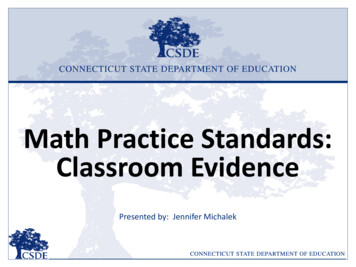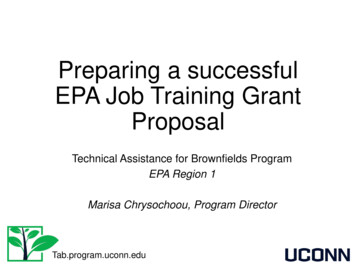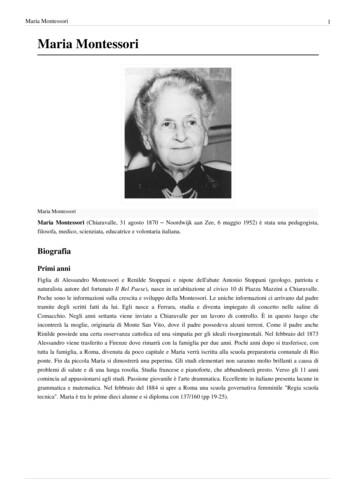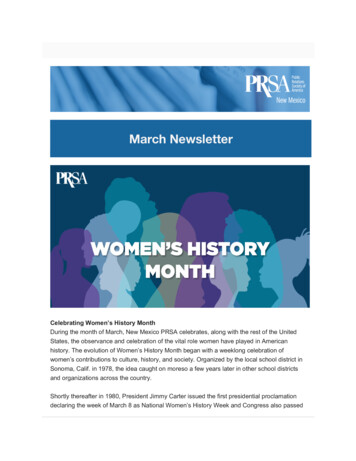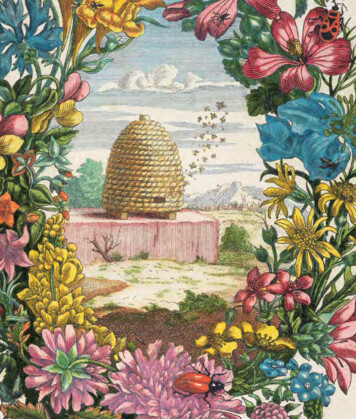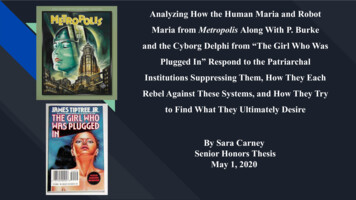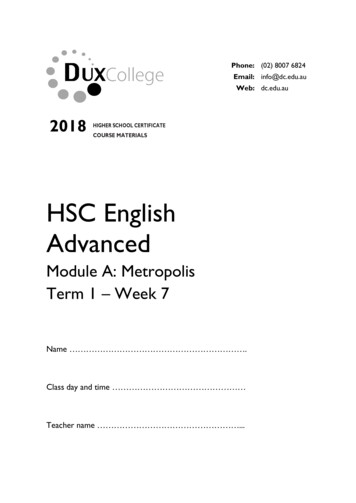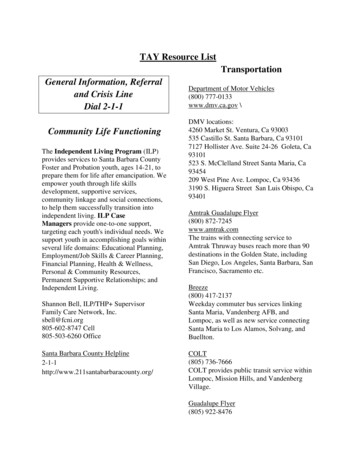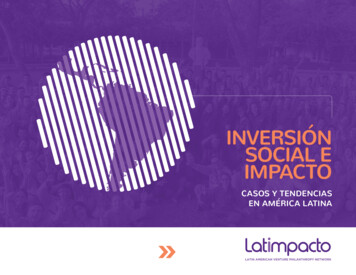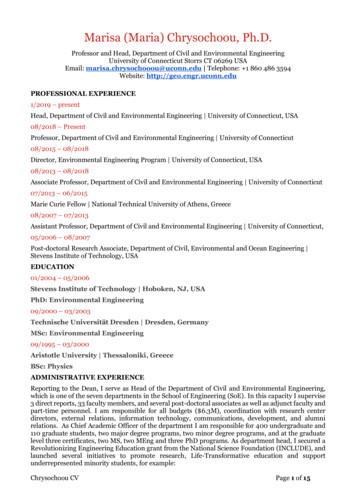
Transcription
Marisa (Maria) Chrysochoou, Ph.D.Professor and Head, Department of Civil and Environmental EngineeringUniversity of Connecticut Storrs CT 06269 USAEmail: marisa.chrysochooou@uconn.edu Telephone: 1 860 486 3594Website: http://geo.engr.uconn.eduPROFESSIONAL EXPERIENCE1/2019 – presentHead, Department of Civil and Environmental Engineering University of Connecticut, USA08/2018 – PresentProfessor, Department of Civil and Environmental Engineering University of Connecticut08/2015 – 08/2018Director, Environmental Engineering Program University of Connecticut, USA08/2013 – 08/2018Associate Professor, Department of Civil and Environmental Engineering University of Connecticut07/2013 – 06/2015Marie Curie Fellow National Technical University of Athens, Greece08/2007 – 07/2013Assistant Professor, Department of Civil and Environmental Engineering University of Connecticut,05/2006 – 08/2007Post-doctoral Research Associate, Department of Civil, Environmental and Ocean Engineering Stevens Institute of Technology, USAEDUCATION01/2004 – 05/2006Stevens Institute of Technology Hoboken, NJ, USAPhD: Environmental Engineering09/2000 – 03/2003Technische Universität Dresden Dresden, GermanyMSc: Environmental Engineering09/1995 – 03/2000Aristotle University Thessaloniki, GreeceBSc: PhysicsADMINISTRATIVE EXPERIENCEReporting to the Dean, I serve as Head of the Department of Civil and Environmental Engineering,which is one of the seven departments in the School of Engineering (SoE). In this capacity I supervise3 direct reports, 33 faculty members, and several post-doctoral associates as well as adjunct faculty andpart-time personnel. I am responsible for all budgets ( 6.3M), coordination with research centerdirectors, external relations, information technology, communications, development, and alumnirelations. As Chief Academic Officer of the department I am responsible for 400 undergraduate and110 graduate students, two major degree programs, two minor degree programs, and at the graduatelevel three certificates, two MS, two MEng and three PhD programs. As department head, I secured aRevolutionizing Engineering Education grant from the National Science Foundation (INCLUDE), andlaunched several initiatives to promote research, Life-Transformative education and supportunderrepresented minority students, for example:Chrysochoou CVPage 1 of 15
The INCLUDE project is revamping all academic practices in the department and beyond tosupport neurodivergent students and raise awareness on the importance of neurodiversity forengineering innovation.Undergraduate Research Initiative, providing summer internships and academic year supportfor undergraduate students to work in research laboratories, prioritizing minority students.Priority Teaching Assistant support for U.S. minority graduate students.Graduate Leadership Initiative, supporting conference travel for graduate students withdemonstrated leadership record.Antiracism and Equity Action committee.Future Leaders Internship program, matching students to premier employers in the region.Small grant initiative for interdisciplinary research, providing up to 20K for CEE faculty toinitiate research collaborations outside the department.Expanded range of online and intersession courses offered at the undergraduate and graduatelevel, increasing department revenue.FUNDED PROJECTS1. “EPA Region 1: Technical Assistance for Brownfields Program” 10/21-09/26, 1,000,000, U.S.Environmental Protection Agency, PI: Maria Chrysochoou, co-PIs: Nefeli Bompoti, DavidDickson, Rupal Parekh.2. “Risk Management of Pyrrhotite-Induced Concrete Deterioration” 09/21-09/24. 1,400,000,National Institute of Standards and Technology, PI: Kay Wille, co-PIs: Maria Chrysochoou(share 40%), James Mahoney.3. “Development of a Risk Assessment Framework for Pyrrhotite-Induced Concrete Damage”09/20-09/22. 1,100,000, National Institute of Standards and Technology, PI: Kay Wille, coPIs: Maria Chrysochoou (share 40%), James Mahoney.4. “IUSE/PFE:RED Innovation Beyond Accommodation: Leveraging Neurodiversity forEngineering Innovation”. 01/20-12/24. 2,000,000. National Science Foundation, PI: MariaChrysochoou co-PIs: R. Gabriel, P. Diplock, A. Zaghi, A. Bagtzoglou.5. “Redefining Public Engagement at the University of Connecticut: Studying the Impact of anInnovative STEM Service Learning Model on the University Community”. 10/19-09/24, 2,250,000, National Foundation PI: C. Arnold, co-PIs, M. Chrysochoou (share 20%), J. Volin,T. Campbell, P. Diplock.6. “The Connecticut Brownfields Initiative”. 01/18-08/22, 141,000, CT Department of Economicand Community Development, PI: Maria Chrysochoou7. “Evaluation of Grid Resilience Activities with a Total System Performance Assessment Modelinformed by Optimization and Economic Methodologies”, 01/18-12/19. 292,000. EversourceEnergy Center, PI: A. Bagtzoglou, co-PIs: W. Zhang, P. Borochin, M. Chrysochoou (share 20%)8. “A bottom-up approach to design of chemical soil stabilization using thermodynamicmodeling”. 7/17-7/22, 256,694, National Science Foundation, PI: Maria Chrysochoou9. “Laboratory Testing for Sediment Resuspension Mitigation”. 12/16-06/17, 12,650, SESIConsulting Engineers, PI: Maria Chrysochoou (share: 60%), co-PI: Ross Bagtzoglou10. “Investigation of Capillary Rise Induced Chromium Blooms”. 08/15-08/17, 125,000, AECOM,PI: Maria Chrysochoou (share: 80%), co-PI: Ross Bagtzoglou11. “Collaborative Research: Toward a unified model for ferrihydrite behavior in the environment:a multipronged investigation of surface structure and reactivity”, 10/14-10/18, 440,000,National Science Foundation: PIs: Maria Chrysochoou (share 236,500) and Nadine Kabengi(Georgia State University)12. “XRD and SEM characterization of Cr-contaminated samples”, 04/14-06/14 10,850, AECOM,PI: Maria Chrysochoou13. “XRD and SEM characterization of soil and historic fill materials”, 04/14-09/14, 21,000,CB&I, PI: Maria Chrysochoou14. “SPECHROM— Spectroscopic and computational investigation of chromium binding on pureminerals and Asopos aquifer soils”, 07/13-06/15, 222,483, Marie Curie InternationalIncoming Fellowship, National Technical University of Athens15. “Evaluating Applications of Field Spectroscopy Devices to Fingerprint Commonly UsedConstruction Materials: Phase IV”, 04/13-04/14, 187,000, Strategic Highway ResearchProgram 2, PI: Maria ChrysochoouChrysochoou CVPage 2 of 15
16. “Sustainable erosion control in developing countries using industrial by-products”, U.S.Environmental Protection Agency, 08/11-08/12, 15,000, PI: Maria Chrysochoou17. “Development of GIS and prioritization strategies for brownfield reclamation”, CT Departmentof Economic and Community Development, 06/11-06/12, 22,200, PI: Maria Chrysochoou18. “Strengthening and modeling of earth embankments under high loads”, U.S. Department ofHomeland Security, 09/09-09/10, 118,189, PI: Maria Chrysochoou (share: 45%). Co-PIs:Dipanjan Basu, Amvrossios Bagtzoglou19. “XRD and SEM characterization of PPG Chromite Ore Processing Residue samples”, AECOM,01/10-05/10, 8,800, PI: Maria Chrysochoou20. “Evaluating Applications of Field Spectroscopy Devices to Fingerprint Commonly UsedConstruction Materials: Phases I-III”, 02/09-04/13, 400,000, Strategic Highway ResearchProgram 2, PI: Adam Zofka, co-PIs: Maria Chrysochoou (share: 25%), Monty Shaw, JimMahoney21. “Investigation of the use of nanoscale Zero Valent Iron for Cr remediation in contaminatedsoils”, UConn Research Foundation, 06/09-06/10, 26,435, PI: Maria Chrysochoou22. “Reversing Urban Sprawl: A Reclaimability Index Approach for Reviving DowntownBrownfields”, Center for Transportation and Livable Systems, U.S. Department ofTransportation, 08/08-08/10, 242,405 PI: Maria Chrysochoou (share: 55%) co-PIs: NormanGarrick, Kathleen Segerson, Amvrossios Bagtzoglou23. “Column studies for treatment optimization at National Chromium”, National Chromium Inc.,10/08 - 10/09, 10,000 PI: Maria Chrysochoou24. “Analysis of soil-cement blending samples”, Schnabel Engineering, 09/08-11/08, 3,350 PI:Maria Chrysochoou25. “Analysis of Al-rich powders”, Schnabel Engineering, 03/08-05/08, 6,200 PI: MariaChrysochoou26. “Cr-treatability study at the National Chromium Facility”, National Chromium Inc., 02/0808/08. 8,000 PI: Maria Chrysochoou27. “Soil-cement blending study, Greenport, NY”. Schnabel Engineering, 01/08/08-04/30/08. 4,500 PI: Maria Chrysochoou28. “Investigation of Cr(VI) speciation via micro-XANES, micro-XRF and micro-XRD analyses”,Uconn Research Foundation, 10/07, 1,000 PI: Maria Chrysochoou29. “LaFarge-Dominion Portland Cement–Fly Ash–Dredged Material blend evaluation”, SchnabelEngineering, 09/07-04/08 12,000 PI: Maria ChrysochoouCONSULTING ACTIVITIES 2016-2019, Subject Matter Expert, CH2MHILL and Federal Highway Administration, SHRP2Implementation Assistant Program, Round 7.2016, Consultant, Phoenix Environmental Services, Evaluation and modeling ofenvironmental data.2014-present, Consultant and Expert Witness, CB&I, Evaluation of the nature of historic fillmaterials in contaminated sites.2014-present, Consultant and Expert Witness, AECOM, Investigation of chromium speciationin contaminated sites.2014, Consultant, Strategic Highway Research Program 2 (SHRP2), Transportation ResearchBoard, Webinar presenter2012-2013, Consultant and Expert Witness, Kohl’s Department Store, Investigation of heavingmechanisms in foundation material.2011-2013, Consultant, National Technical University of Athens, Greece. Project LIFE :Chromium in Asopos Groundwater System: Remediation Technologies and Measures –“CHARM”2012, Organization and delivery of ASCE Webinar: Geochemistry: An important tool for GeoEnvironmental engineers (offered January 10th 2011, April 9th 2012, October 3rd 2012).2011, Environmental Professionals Organization of Connecticut, Organization of professionalseminar on in situ remediation technologies.2010, Schnabel Engineering, Project Consultant.TEACHINGChrysochoou CVPage 3 of 15
UndergraduateBrownfield Redevelopment (2018, 2019, 2020, 2021)Soil Mechanics I (2007-2013, 2015-2018)Geoenvironmental Engineering (2017)Air Pollution (2012, 2013, 2016)Environmental Senior Design (2010)Environmental Debate (2008)GraduateGeoenvironmental Engineering (online, 2018)Contaminant Source Remediation (2010)Environmental Transport Phenomena (2009)Environmental Geotechnology (2005, Stevens Institute of Technology)ADVISINGCurrent Post-docs and Graduate AdviseesRandi Mendes (Post-doctoral research associate)Tarique Md Hasan (Post-doctoral research associate)Tasneem Ahmadullah (PhD student)Leana Santos (PhD student)Bernard Sarpong (PhD student)Ogochukwu Okeke (Ph.D. student)Caressa Wakeman (PhD student)Naomi Adler (MS student)PhD students graduated and current placementYaguang Du, 2019; Assistant Professor, South Central University for Nationalities, Wuhan,ChinaNefeli Bompoti, 2017; Assistant Research Professor, University of ConnecticutChad Johnston, 2012; Assistant Professor, Loyola UniversityMS students graduatedKelly Drengler (2008), Aaron Ting (2010), Matthew Rood (2010), Geeta Dahal (2010),Xiaolong Zhang (2010), Jacqueline Oakes (2013), Jaclyn Sidman (2021)Visiting students/scholars supervisedMarie Laure Ducasse (2008), Wang Zhe (2009), Guo Li (2017)CITATIONSScopus: 2065 h-index 25Google Scholar: 2735, h-index 28PUBLICATIONSBook Chapters1. Chrysochoou M. 2020 Understanding soil-contaminant interactions: a key to improvedgroundwater quality, In: Women in Water Quality: Investigations by Prominent FemaleEngineers, Editor: Deborah O’Bannon. Springer, pp. 185-196.Chrysochoou CVPage 4 of 15
2. Chrysochoou M. and Bompoti N. Laboratory testing for Chemical Characterization of Solids,Gas and Liquids, Manual of Geoenvironmental Engineering Professional Practice, AmericanSociety of Civil Engineers (expected publication date, June 2020).3. Kabengi N. and Chrysochoou M., 2015. Soil Science in Environmental Management. In: AnIntegrated Approach to Environmental Management, Editors: Rupali Datta, John Wiley andSons, pp. 75-98.4. Chrysochoou M., 2013. Application of quantitative X-ray Diffraction in Geoenvironmentalproblems: overview and case studies, Chapter 5, In: X-ray Diffraction: Structure, Principlesand Applications, Editor: Kaimin Shih, Nova Science Publishers.5. Chrysochoou M. and Dermatas D., 2011. An overview of the properties and treatment ofChromite Ore Processing Residue, In: Management of hazardous residues containing Cr(VI),Nova Science Publishers, pp. 273-302.Journal papers published1. Chester Arnold, Juliana Barrett, Todd Campbell, Maria Chrysochoou, Nefeli Bompoti, 2021.The Environment Corps: Combining classroom Instruction, service-learning and extensionoutreach to create a new model of community engaged scholarship at the University ofConnecticut, Journal of Higher Education Outreach and Engagement, 25(2), 215-232.2. Campbell-Montalvo R., Campbell T., Park E.Y., Arnold C., Volin J., Chrysochoou M andDiplock P. 2021. E-Corps’ Implementation of Environmental Sustainability-Focused ServiceLearning: Conditions Supporting the Establishment of an Epistemic Community, Journal ofSTEM Outreach, 4(1), 1-12.3. Cruz-Hernandez Y., Chrysochoou M. and Wille K. 2020. Wavelength dispersive X-rayfluorescence method to estimate the oxidation reaction progress of sulfide minerals inconcrete, Spectrochimica Acta Part B: Atomic Spectroscopy 172, 1059494. P Yue, N Chen, D Peak, NM Bompoti, M Chrysochoou, A Onnis-Hayden, 2020, Oxygen atomrelease during selenium oxyanion adsorption on goethite and hematite, AppliedGeochemistry, 046055. Du Y. and Chrysochoou M. 2020. Microstructural Analyses of Cr(VI) Speciation in ChromiteOre Processing Residue from the Soda Ash Process, Journal of Hazardous Materials, 122385.6. Kollias K., Mylona E., Adam K., Chrysochoou M., Papassiopi N. and Xenidis A. 2019.Characterization of phosphate coating formed on pyrite surface to prevent oxidation, AppliedGeochemistry, 110, 104435.7. Bompoti N., Chrysochoou M. and Machesky M. 2019. A unified surface complexationmodeling approach for chromate adsorption on iron oxides, Environmental Science andTechnology, 53(11), 6352-6361.8. Bompoti N., Chrysochoou M. and Machesky M. 2018., Assessment of modeling uncertaintiesusing a multi-start optimization tool for surface complexation equilibrium parameters(MUSE), ACS Earth and Space Chemistry, 3(4), 473-483.9. Chrysochoou M., Oakes J. and Dyar D. 2018. Investigation of iron reduction by green teapolyphenols, Applied Geochemistry, 97, 263-269.10. Chrysochoou M. and Du Y. 2018. Experimental and modeling behavior of Chromite OreProcessing Residue from the soda ash process, Environmental Engineering Science, 35(11),1185-1193.11. Kubicki J., Kabengi N., Chrysochoou M. and Bompoti N. 2018. Density functional theorymodeling of chromate adsorption onto ferrihydrite nanoparticles, Geochemical Transactions,19:8, https://doi.org/10.1186/s12932-018-0053-8.12. Lagiopoulos I., Binteris A., Mpouras T., Panagiotakis I., Chrysochoou M. and Dermatas D.2017. Potential biosorbents for treatment of chromium(VI)-contaminated water dischargedinto Asopos River, International Journal of Environmental Science and Technology, 14(7),1481-1488.13. Chrysochoou M., and Reeves K. 2017. Investigation of hexavalent chromium reduction bygreen tea polyphenols, Bulletin of Environmental Contamination and Toxicology, 98(3), 353358.14. Mpouras T., Chrysochoou M. and Dermatas D. 2017. Investigation of hexavalent chromiumsorption on serpentine soil, Journal of Contaminant Hydrology, 197, 29-38.15. Bompoti N., Chrysochoou M. and Machesky M., 2017. Surface structure of ferrihydrite:Insights from modeling surface charge. Chemical Geology, 464, 34-45.Chrysochoou CVPage 5 of 15
16. Kabengi N., Chrysochoou M., Bompoti N. and Kubicki J. 2017. An integrated flowmicrocalorimetry, infrared spectroscopy and density functional theory approach to the studyof chromate complexation on hematite and ferrihydrite, Chemical Geology, 464, 23-33.17. Chrysochoou M., Theologou E., Bompoti N., Dermatas D. and Panagiotakis I. 2016.Occurrence, Origin and Transformation Processes of Geogenic Chromium in Soils andSediments, Current Pollution Reports, 2(4), 224-235.18. Johnston C. and Chrysochoou M. 2016. Mechanisms of Chromate, Selenate, and SulfateAdsorption on Al-Substituted Ferrihydrite: Implications for Ferrihydrite Surface Structureand Reactivity, Environmental Science and Technology, 50(7), 3589-3596.19. Bompoti N., Chrysochoou M. and Dermatas D. 2015. “Geochemical characterization of Greekophiolitic environments using statistical analysis”, Environmental Processes, 2, (Suppl 1), S5S21 DOI: 10.1007/s40710-015-0097-z.20. Chrysochoou M., 2015. “Geochemistry in Geotechnical Engineering Problems: Ettringite asCase Study”, Geotechnical Engineering , 46(4), 1-7.21. Mystrioti C., Sparis D., Papassiopi N., Xenidis A., Dermatas D. and Chrysochoou M. 2015.“Assessment of Polyphenol Coated Nano Zero Valent Iron for Hexavalent Chromium Removalfrom Contaminated Waters” Bulletin of Environmental Contamination and Toxicology,94(3), 302-307.22. Panagiotakis I., Dermatas D., Vatseris C., Chrysochoou M., Papassiopi N., Xenidis A. andVaxevanidou K. 2015. Forensic Investigation of a Chromium(VI) groundwater plume in Thiva,Greece, Journal of Hazardous Materials, 281. 27-34.23. Dermatas D., Mpouras A., Chrysochoou M., Vatseris C., Papassiopi N., Xenidis A., TheologouE. and Bompoti N. 2015. Origin and concentration profile of chromium in a Greek aquifer,Journal of Hazardous Materials, 281, 35-46.24. Chrysochoou M. and Johnston C.P., 2015. Sulfur speciation and reactivity in calciumpolysulfide treated soil, Journal of Hazardous Materials, 281, 87-94.25. Johnston C.P. and Chrysochoou M., 2015. Mechanisms of chromate adsorption on boehmite,Journal of Hazardous Materials, 281, 56-63.26. Mystrioti C., Papassiopi N., Xenidis A., Dermatas D. and Chrysochoou M., 2015.,“Columnstudy for the evaluation of the transport properties of polyphenol coated nano iron”, Journalof Hazardous Materials, 281, 64-69.27. Johnston C.P. and Chrysochoou M., 2014. Mechanisms of chromate adsorption on hematite,Geochimica et Cosmochimica Acta, 138, 146-157.28. Chrysochoou M., 2014. Investigation of mineral dissolution rate and strength development instabilized soils using quantitative X-ray Diffraction, Journal of Materials in CivilEngineering, 26(2), 288-29529. Chrysochoou M., Zhang X and Amador J., 2013. Comparison of Cr(VI) reduction by aerobicbacteria in culture and soil conditions, Soil and Sediment Contamination, 22, 273-287.30. Johnston C.P. and Chrysochoou M., 2012. Investigation of Chromate Coordination onFerrihydrite by in situ ATR-FTIR Spectroscopy and Theoretical Frequency Calculations,Environmental Science and Technology, 46(11), 5851-5858.31. Chrysochoou M., Brown K., Dahal G., Granda C., Segerson K., Garrick N. and Bagtzoglou A.,2012. Decoupling brownfield assessment from end use: A GIS tool and indexing scheme forlong term redevelopment planning, Landscape and Urban Planning, 105(3), 187-198.32. Chrysochoou M., Grubb D.G. and Malasavage N., 2012. Assessment of Sulfate-Induced Swellin Stabilized Dredged Material: Is Ettringite Always a Problem?, Journal of Geotechnical andGeoenvironmental Engineering,138(3), 407-414.33. Chrysochoou M., Johnston C. and Dahal G., 2012. A Comparative Evaluation of Cr(VI)Treatment in Contaminated Soil by Calcium Polysulfide and Nanoscale Zero Valent Iron,Journal of Hazardous Materials, 201-202, 33-42.34. Dermatas D., Vatseris C., Panagiotakis I. and Chrysochoou M., 2012. Potential contribution ofgeogenic chromium in groundwater contamination of a Greek heavily industrialized area,Chemical Engineering Transactions, 28, 217-222.35. Chrysochoou M., McGuire M. and Dahal G., 2012. Transport Characteristics of Green-TeaNano-scale Zero Valent Iron as a Function of Soil Mineralogy, Chemical EngineeringTransactions, 28, 121-126.36. Chrysochoou M. and Ting A., 2011. A kinetic study of Cr(VI) reduction by calcium polysulfide,Science of the Total Environment, 409, 4072-4077.Chrysochoou CVPage 6 of 15
37. Chrysochoou M., Granda C., Brown K., Dahal G., Garrick N., Segerson K. and Bagtzoglou A.,2011. Reviving Connecticut’s brownfields: institutions and obstacles, The ConnecticutEconomy, 19(1), 14-16.38. Chrysochoou M., Grubb D.G., Drengler K. and Malasavage N., 2010. Stabilized DredgedMaterial III: A mineralogical perspective, Journal of Geotechnical and GeoenvironmentalEngineering, 136(8), 1037-1050.39. Grubb D.G., Malasavage N., Smith C.J and Chrysochoou M., 2010. Stabilized DredgedMaterial II: Geomechanical behavior, Journal of Geotechnical and GeoenvironmentalEngineering, 136(8), 1025-1036.40. Grubb D.G., Chrysochoou M., Smith C.J. and Malasavage N., 2010. Stabilized DredgedMaterial I: A parametric study, Journal of Geotechnical and Geoenvironmental Engineering,136(8), 1011-1024.41. Chrysochoou M., Ferreira D. and Johnston C., 2010. Calcium polysulfide treatment of Crcontaminated soil, Journal of Hazardous Materials, 179, 650-657.42. Chrysochoou M., Dermatas D., Moon D.H., Grubb D.G. and Christodoulatos C., 2010.Geoenvironmental characterization of Chromite Ore Processing Residue: Implications fortreatment, Journal of Geotechnical and Geoenvironmental Engineering, 136(3), 510-521.43. Chrysochoou M., Fakra S., Marcus. M.A., Moon D.H. and Dermatas D., 2009. MicrostructuralAnalyses of Cr(VI) Speciation In Chromite Ore Processing Residue (COPR), EnvironmentalScience and Technology, 43(14), 5461-5466.44. Chrysochoou M., Moon D.H., Fakra S., Marcus M.A., Dermatas D. and Christodoulatos C.,2009. Use of Micro-X-ray Absorption spectroscopy and diffraction to delineate Cr(VI)speciation in COPR, Global NEST Journal, 11(3), 318-324.45. Grubb D.G., Moon D.H., Reilly T., Chrysochoou M., Dermatas D. 2009.Stabilization/solidification (S/S) of Pb and W contaminated soils using type I/II portlandcement, silica fume cement and cement kiln dust, Global Nest Journal 11 (3) , pp. 267-282.46. Chrysochoou M., Dermatas D. and Christodoulatos C., 2009. Experimental studies on coupledtreatment of Chromite Ore Processing Residue, Journal of ASTM International, Vol. 6 No. 3DOI: 10.1520/JAI102165.47. Dermatas D., Chrysochoou M., Grubb D.G. and Xu X., 2008. Phosphate treatment of firingrange soils: Pb fixation or P release?, Journal of Environmental Quality, 37: 47-56.48. Wazne M., Moon D.H., Jagupilla S.C., Jagupilla S.C., Christodoulatos C., Dermatas D.,Chrysochoou M., 2007. Remediation of chromite ore processing residue using ferrous sulfateand calcium polysulfide, Geosciences Journal, 11(2): 105-110.49. Dermatas D. and Chrysochoou M., 2007. Lead particle size and its association with firingconditions and range maintenance: implications for treatment, Environmental Geochemistryand Health, 29(4):347-355.50. Moon D.H., Dermatas D., Wazne M., Sanchez A., Chrysochoou M. and Grubb D.G, 2007.Swelling related to ettringite crystal formation in Chromite Ore Processing Residue,Environmental Geochemistry and Health, 29(4):289-294.51. Chrysochoou M., Dermatas D. and Grubb D.G., 2007. Phosphate application to firing rangesoils for Pb immobilization: the unclear role of phosphate, Journal of Hazardous Materials,144(1-2):1-14.52. Moon D.H., Wazne M., Dermatas D., Christodoulatos C., Sanchez A.M., Grubb D.G.,Chrysochoou M. and Kim M.G., 2007. Long-term treatment issues with chromite oreprocessing residue (COPR): Cr6 reduction and heave, Journal of Hazardous Materials,143(3):629-635.53. Dermatas D., Chrysochoou M., Pardali S. and Grubb D.G., 2007. Influence of X-RayDiffraction sample preparation on quantitative mineralogy: implications for chromate wastetreatment, Journal of Environmental Quality, 36(2):487-497.54. Chrysochoou M. and Dermatas D., 2007. Application of the Rietveld method to assess Cr(VI)speciation in Chromite Ore Processing Residue, Journal of Hazardous Materials, 141(2):370377.55. Dermatas D., Chrysochoou M., Moon D.H., Grubb D.G., Wazne M. and Christodoulatos C.,2006. Ettringite-Induced Heave in Chromite Ore Processing Residue (COPR) upon FerrousSulfate Treatment, Environmental Science and Technology 40(18):5786-5792.Chrysochoou CVPage 7 of 15
56. Chrysochoou M. and Dermatas D., 2006. Evaluation of Ettringite and HydrocalumiteFormation for Heavy Metal Immobilization: Literature Review and Experimental Study,Journal of Hazardous Materials, 136(1):20-33.57. Dermatas D., Shen G., Chrysochoou M., Grubb D.G., Menounou N. and Dutko P., 2006. Pbspeciation vs. TCLP release in army firing range soils, Journal of Hazardous Materials,136(1):34-46.58. Dermatas D., Bonaparte R., Chrysochoou M. and Moon D.H., 2006. Chromite Ore ProcessingResidue: Hazardous Contaminated Soil or Solid Waste?, Journal of ASTM International, Vol.3 No.7, doi: 10.1520/JAI13313.59. Chrysochoou M., Dermatas D., Moon D.H., Christodoulatos C., Wazne M., French C., MorrisJ. and Kaouris M., 2006. Investigation of barium treatment of Chromite Ore ProcessingResidue, Journal of ASTM International Vol. 3 No.6, doi: 10.1520/JAI13314.60. Moon D.H., Dermatas D., Chrysochoou M. and Shen G., 2006. An Investigation of theHeaving Mechanism Related to Chromite Ore Processing Residue, Journal of ASTMInternational Vol. 3 No.6, doi: 10.1520/JAI13309.61. Karagiannidis A., Chrysochoou M., Moussiopoulos N., Samaras Z., and Rakibey P. (2006).Examples of solid waste analysis and characterisation in accordance with contemporaryEuropean environmental legislation, International Journal of Sustainable Development andPlanning, 1(4):464-475.62. Karagiannidis A., Perkoulidis G., Moussiopoulos N. and Chrysochoou M., 2004. Facilitylocation for solid waste management through compilation and multicriterial ranking ofoptimal decentralised scenarios: a case study for the region of Peloponesse in southernGreece, Engineering Research, 1:7-18.CONFERENCE PAPERS AND PRESENTATIONS (past 5 years)Full conference papers1. Chrysochoou M, Zaghi A, Syharat C, Motaref S, Jang S, Bagtzoglou A, Wakeman C.Redesigning Engineering Education for Neurodiversity: New Standards for Inclusive Courses.2021 ASEE Virtual Annual Conference Content Access. 2021 ASEE Virtual AnnualConference; 2021 July 26. Available from: https://peer.asee.org/376472. Du Y. and Chrysochoou M. 2018. Microstructural analyses of Cr(VI) speciation in soda-ashchromite ore processing residue from China, Proceedings of the Air and Waste ManagementAssociation's Annual Conference and Exhibition, AWMA Volume 2018-June, Air and WasteManagement Association's 111th Annual Conference and Exhibition, Hartford, CT.3. Bompoti N., Chrysochoou M. and Machesky M. 2016. Advances in surface complexationmodeling for chromium adsorption on iron oxide, GeoChicago 2016, Sustainability, Energy,and the Geoenvironment, Chicago, IL, August 14-18.4. Du Y. and Chrysochoou M. 2016. The leaching characteristics of Chromite Ore ProcessingResidue from China, GeoChicago 2016, Sustainability, Energy, and the Geoenvironment,Chicago, IL, August 14-18.5. Binteris Α., Mpouras Τ., Panagiotakis Ι., Dermatas D., Chrysochoou M., 2015. Reed material –A potential biosorbent for the treatment of Cr(VI)-contaminated water discharged into Asoposriver, 14th Conference on Environmental Science and Technology, Rhodes, Greece, September2015, paper 01428.6. Lagiopoulos I., Panagiotakis Ι., Chrysochoou M., Dermatas D., 2015. Treatment of Cr(VI)contaminated water discharged to Asopos river using low-cost natural materials, Conferenceon Environmental Science and Technology, Rhodes, Greece, September 2015, paper 01426.7. Chrysochoou M., Bompoti N., Dermatas D. and Theologou E. 2014. Identification of Cr and Niorigin in Greek soils via R-mode factor analysis, paper A408, Proceedings of the 12thInternational Conference on Protection and Restoration of the Environment, Skiathos,Greece, June 29 – July 3 2014.8. Mpouras T., Dermatas D. and Chrysochoou M., 2014. Evaluation of the adsorption ofhexavalent chromium on ophiolitic soils, paper A409, Proceedings of the 12th InternationalConference on Protection and Restoration of the Environment, Skiathos, Greece, June 29 –July 3 2014.9. Panagiotakis, D. Dermatas, C. Vatseris, P. Merkos, M. Chrysochoou, N. Linardos,T. Mpouras,E. Theologou, N. Papassiopi A. Xenidis, 2014. Assessment of a Cr(VI)-contaminated industrialChrysochoou CVPage 8 of 15
site in Greece, paper A410, Proceedings of the 12th International Conference on Protectionand Restoration of the Environment, Skiathos, Greece, June 29 – July 3 2014.10. Mystrioti C., Xenidis A., Papassiopi N., Dermatas D. and Chrysochoou M., 2014. “Fate ofgreen tea iron nanoparticles in calcareous soils”, Geotechnical Special Publication 234, 21892198.11. Mpouras T., Panagiotakis I., Dermatas D. and Chrysochoou M., 2014. Nano-zero valent iron:An emerging technology for contaminated site remediation, Geotechnical Special Publication234, 2206-2215.12. Chrysochoou M., Machesky M. and Johnston C., 2013. A new surface complexation model forchromate adsorption on ferrihydrite. Proceedings of the 13th International Conference onEnvironmental Science and Technology, paper 687, Athens, Greece, 5-7 September 2013.13. Kabengi N., Chrysochoou M., Johnston C.P. and Tulloch J., 2013. Elucidating mechanisms ofchromate complexation on iron oxide surfaces using flow calorimetry and infraredspectroscopy. Proceedings of the 13th International Conference on Environmental Scienceand Technology, paper 552, Athens, Greece, 5-7 September 2013.14. Theologou E., Panagiotakis I., Dermatas D., Chrysochoou M. and Toskos T., 2013.Remediation technologies for hexavalent chromium contaminated aquifers. Proceedings ofthe 13th International Conference on Environmental Science and Technology, paper 815,Athens, Greece, 5-7 September 2013.15. Mystrioti C., Papassiopi N., Xenidis A., Dermatas D. and Chrysochoou M., 2013. Columnstudy for the evaluation of transport properties of polyphenol coated nano-ir
110 graduate students, two major degree programs, two minor degree programs, and at the graduate level three certificates, two MS, two MEng and three PhD programs. As department head, I secured a Revolutionizing Engineering Education grant from the National Science Foundation (INCLUDE), and
